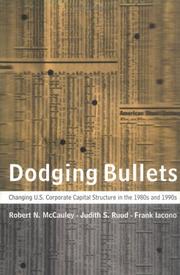| Listing 1 - 5 of 5 |
Sort by
|
Book
Year: 2007 Publisher: Washington, D.C. : Congressional Budget Office,
Abstract | Keywords | Export | Availability | Bookmark
 Loading...
Loading...Choose an application
- Reference Manager
- EndNote
- RefWorks (Direct export to RefWorks)
Deposit insurance --- Federal Deposit Insurance Corporation.
Book
Year: 2004 Publisher: [Washington, D.C.] : Congress of the U.S., Congressional Budget Office,
Abstract | Keywords | Export | Availability | Bookmark
 Loading...
Loading...Choose an application
- Reference Manager
- EndNote
- RefWorks (Direct export to RefWorks)
Book
Year: 2002 Publisher: [Washington, D.C.] : Congress of the United States, Congressional Budget Office,
Abstract | Keywords | Export | Availability | Bookmark
 Loading...
Loading...Choose an application
- Reference Manager
- EndNote
- RefWorks (Direct export to RefWorks)
Book
Year: 2002 Publisher: [Washington, D.C.] : Congress of the U.S., Congressional Budget Office,
Abstract | Keywords | Export | Availability | Bookmark
 Loading...
Loading...Choose an application
- Reference Manager
- EndNote
- RefWorks (Direct export to RefWorks)
Banks and banking --- International economic relations. --- Economic aspects

ISBN: 0262133512 026227938X 058517623X 0262263661 9780262279383 9780585176239 9780262133517 Year: 1999 Publisher: Cambridge Mass. MIT Press
Abstract | Keywords | Export | Availability | Bookmark
 Loading...
Loading...Choose an application
- Reference Manager
- EndNote
- RefWorks (Direct export to RefWorks)
An entertaining summary of the broad reshaping of U.S. corporate finance in the last decade and a half.The late 1980s saw a huge wave of corporate leveraging. The U.S. financial landscape was dominated by a series of high-stakes leveraged buyouts as firms replaced their equity with new fixed debt obligations. Cash-financed acquisitions and defensive share repurchases also decapitalized corporations. This trend culminated in the sensational debt-financed bidding for RJR-Nabisco, the largest leveraged buyout of all time, before dramatically reversing itself in the early 1990s with a rapid return to equity.This entertaining summary of the broad reshaping of U.S. corporate finance in the last decade and a half looks at three major issues: why corporations leveraged up in the first place, why and how the leverage wave came to an end, and what policy lessons are to be drawn.Using the Minsky-Kindleberger model as a framework, the authors interpret the rise and fall of leveraging as a financial market mania. In the course of chronicling the return to equity in the 1990s, they address a number of important corporate finance questions: How important was the return to equity in relieving corporations' debt burdens? How did the return to equity affect the ability of young high-tech firms to finance themselves without selling out to foreign firms?
Leveraged buyouts --- Consolidation and merger of corporations --- Corporations --- History --- Finance --- Business corporations --- C corporations --- Corporations, Business --- Corporations, Public --- Limited companies --- Publicly held corporations --- Publicly traded corporations --- Public limited companies --- Stock corporations --- Subchapter C corporations --- Acquisition of corporations --- Acquisitions and mergers --- Amalgamation of corporations --- Business combinations --- Business mergers --- Buyouts, Corporate --- Corporate acquisitions --- Corporate buyouts --- Corporate mergers --- Corporate takeovers --- Fusion of corporations --- Hostile takeovers of corporations --- M & A (Mergers and acquisitions of corporations) --- Merger of corporations --- Mergers and acquisitions of corporations --- Mergers, Corporate --- Takeovers, Corporate --- Buyouts, Leveraged --- LBOs (Corporations) --- Leveraged buy-outs --- Consolidation --- Mergers --- Business enterprises --- Corporate power --- Disincorporation --- Stocks --- Trusts, Industrial --- Corporate reorganizations --- Golden parachutes (Executive compensation) --- Industrial concentration --- ECONOMICS/Finance
| Listing 1 - 5 of 5 |
Sort by
|

 Search
Search Feedback
Feedback About UniCat
About UniCat  Help
Help News
News